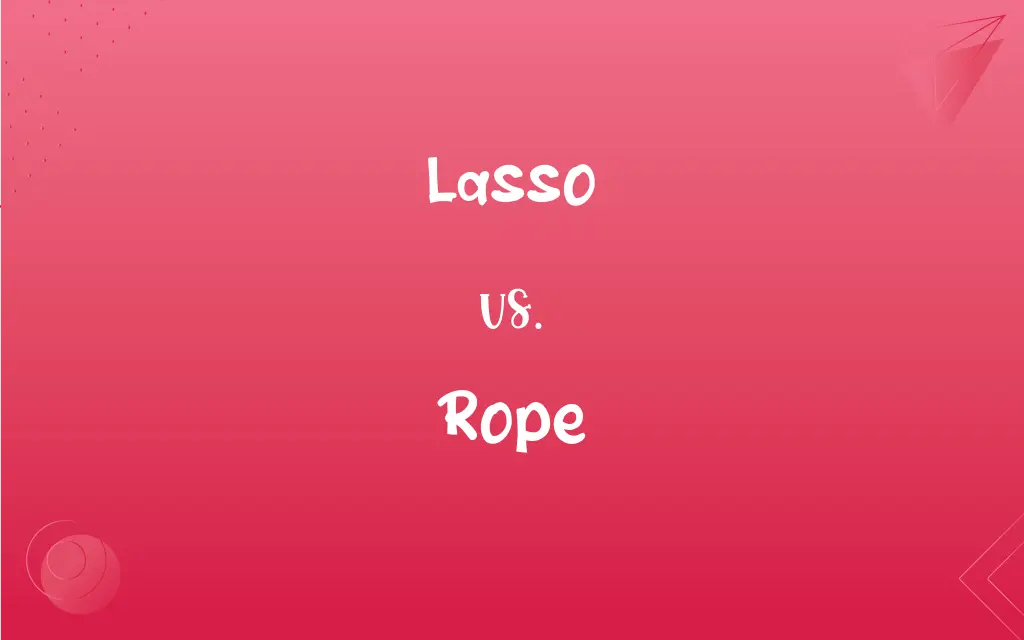Lasso vs. Rope: What's the Difference?
Edited by Aimie Carlson || By Harlon Moss || Updated on November 2, 2023
A lasso is a loop of rope designed to catch animals, while a rope is a long, thick cord made from strands twisted or braided together.

Key Differences
A lasso is specifically designed for catching animals by the neck or limbs, fashioned into a loop that tightens under strain. Rope, however, is a versatile tool used in various activities, from climbing to construction, without the specific design for snaring.
The lasso is a symbol of the cowboy's trade, integral to cattle herding and rodeo shows. Rope, while used by cowboys, also has maritime, industrial, and recreational applications, indicating its broader utility.
When it comes to construction, a lasso is rarely the tool of choice; its specialized loop is not made for securing materials. In contrast, rope is essential on a construction site for lifting, pulling, and securing loads.
In sports, one would not use a rope to capture opponents; however, lassos are used in rodeo sports specifically for roping calves and steers. Meanwhile, rope finds its place in sports like tug-of-war or as part of obstacle courses in adventure races.
In terms of materials, lassos are often made from a stiff rope to hold the loop’s shape, but ropes can be made from a variety of materials like hemp, nylon, or polypropylene, chosen for different properties like strength, flexibility, or resistance to wear.
ADVERTISEMENT
Comparison Chart
Primary Function
Designed to catch animals.
Used for tying, securing, lifting, or climbing.
Form
Typically features a loop with a slipknot.
Comes in various forms without specific shaping.
Cultural Symbolism
Associated with cowboys and rodeo culture.
Ubiquitous, found in many aspects of daily life.
Material
Often made of a stiffer rope to maintain loop shape.
Made from various materials for different uses.
Use in Sports
Used in rodeo events.
Used in activities like climbing, rescue, or sports.
ADVERTISEMENT
Lasso and Rope Definitions
Lasso
A tool used in rodeos for roping cattle or horses.
The cowboy’s lasso spun above his head before he released it.
Rope
A length of fibers twisted or braided together for strength.
She bought a length of rope to make a new swing for the backyard.
Lasso
A rope with a noose for catching livestock.
He skillfully threw the lasso over the runaway steer.
Rope
A strong, thick line made by twisting fibers together.
He secured the boat to the dock with a sturdy rope.
Lasso
A symbol of the American West's cowboy culture.
The lasso hung on the wall as a reminder of his ranching days.
Rope
A versatile implement found in various sports and exercises.
He included rope jumps in his workout for better coordination.
Lasso
A looped rope designed to tighten when pulled.
She practiced with the lasso until she could catch the fence post.
Rope
A tool used in climbing, rescue, or as a simple tie-down.
The climbers checked their rope before beginning the ascent.
Lasso
A method of capturing animals in the wild.
Using a lasso, the ranger was able to safely catch the wild horse.
Rope
An essential piece of equipment in nautical activities.
The sailors coiled the ropes neatly on the deck.
Lasso
A long rope with a running noose at one end, used especially to catch horses and cattle. Also called lariat.
Rope
A flexible heavy cord of tightly intertwined hemp or other fiber.
Rope
A string of items attached in one line, especially by twisting or braiding
A rope of onions.
FAQs
How do you make a lasso?
A lasso is made by forming a loop at the end of a rope with a slipknot.
Can any rope be used as a lasso?
Not all ropes are suitable for lassos; they need to be stiff enough to hold a loop.
What is a lasso used for?
A lasso is used for catching animals, particularly in ranching and rodeo.
Is rope material important for safety?
Yes, choosing the correct rope material is crucial for safety in activities like climbing.
Do lassos come in different sizes?
Yes, lassos can vary in length and loop size depending on their intended use.
Is there a specific way to store rope?
Rope should be coiled or hung to prevent tangles and kinks.
Can ropes be spliced to extend their length?
Many types of rope can be spliced to make them longer or to create loops.
Are lassos only used by cowboys?
While cowboys are known for using lassos, they're also used by animal handlers and in sports.
What’s the difference between a lasso and a lariat?
Lariat is another name for a lasso, particularly in rodeo terminology.
What kind of rope is best for marine use?
Marine ropes should be resistant to water, UV light, and abrasion.
Do all lassos have a wooden handle?
Not all lassos have a wooden handle; some are simply looped rope.
Can ropes be used for towing?
Yes, certain types of rope are designed for towing vehicles.
Is it hard to learn to throw a lasso?
Throwing a lasso requires practice to master the technique.
Can old ropes be recycled?
Some ropes can be recycled, depending on the material they are made from.
Are lassos considered weapons?
Lassos are not typically considered weapons but as tools for animal herding.
How long can a rope last?
The lifespan of a rope depends on its material and how well it's maintained.
How do you clean a rope?
Most ropes can be gently washed with water and a mild detergent.
What’s the maximum weight a rope can hold?
The maximum weight depends on the rope's thickness, material, and construction.
Are lassos used in modern ranching?
Yes, lassos are still used in modern ranching for animal handling.
Can you use a lasso for climbing?
Lassos are not designed for climbing; climbing ropes should be used instead.
About Author
Written by
Harlon MossHarlon is a seasoned quality moderator and accomplished content writer for Difference Wiki. An alumnus of the prestigious University of California, he earned his degree in Computer Science. Leveraging his academic background, Harlon brings a meticulous and informed perspective to his work, ensuring content accuracy and excellence.
Edited by
Aimie CarlsonAimie Carlson, holding a master's degree in English literature, is a fervent English language enthusiast. She lends her writing talents to Difference Wiki, a prominent website that specializes in comparisons, offering readers insightful analyses that both captivate and inform.































































